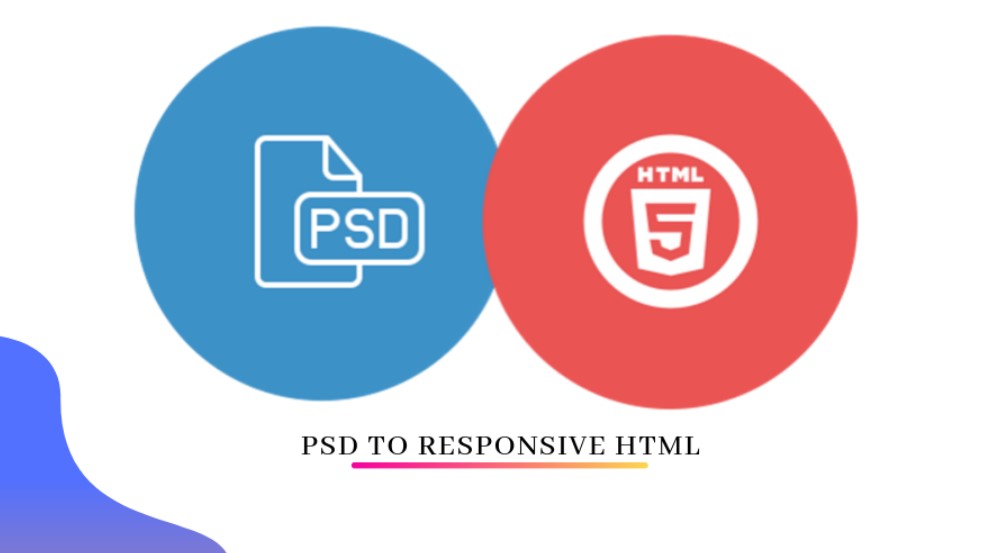
It takes a lot of time to turn a PSD file into a responsive HTML website. However, we are providing a simple guideline for converting your PSD file into a responsive HTML website via this blog.
Entrepreneurs nowadays are frequently concerned about their company’s online presence. As a result, they strive to leave no stone unturned in terms of creating web pages that effectively express every critical feature of their business.
The web development industry has undergone numerous changes. HTML5 and responsive design are currently popular in the market. Today, the best PSD to responsive HTML conversion approach is required to empower brands and establish businesses with a unique image through the website.
Although the process is difficult, before diving into the guide to convert PSD to HTML, let’s first understand the fundamentals.
What exactly is PSD to HTML Conversion?
Photoshop Document is referred to as PSD, and Hypertext Markup Language is referred to as HTML. A webpage layout is created by the graphic designer in Photoshop and saved as a PSD file. The process of transforming this PSD file into a markup language is known as “PSD to HTML conversion.” The majority of custom website development is done via PSD to HTML conversion.
Furthermore, the procedure entails converting PSD designs into functional HTML tags. As a result, static PSD slices are transformed into dynamic web pages. HTML elements, serve as the foundation for web pages, resulting in web pages that are both professional and user-centered. Additionally, some of the most well-known advantages of using this method include clean and semantic coding websites, pixel-perfect conversion, W3C validated websites, cross-browser compatibility, and so on.
What is the PSD to HTML Conversion Steps?
Here are some of the steps that professionals take when converting PSD to HTML responsive online.
PSD to Responsive HTML Conversion Guidelines
The directives that follow will explain how to convert a PSD file into responsive HTML. Furthermore, it will assist you in clearly understanding the process and completing the conversion.
Make a PSD design
To begin, you should be familiar with every aspect of the website so that you can quickly sketch a design for your web page and ensure that every element such as the sidebar, navigation, footer, and so on is properly placed. Second, create the design on a Photoshop Layer because this will allow you to select the relevant element without using the Photoshop slice tool.
Appropriate Color Scheme
A good color combination is essential for expressing content and making web content appealing. As a result, spend some time experimenting with different colors and their properties until you find the perfect color scheme for your design.
Several articles provide more in-depth information for making a suitable color selection. Consider Thomas Canon’s content, “An Introduction to Color Theory for Web Designers.” This article has beautifully presented a comprehensive guide to selecting the best colors.
Begin HTML5 development.
HTML5 includes a plethora of advanced features that allow developers to create web pages with exceptional functionality. The use of third-party applications or plugins has been reduced by this web technology. The W3C has declared HTML5 as a worldwide standard. HTML5 differs from HTML in that it includes many attributes that make it easier to define different types and sections of documents.
Most of us are unaware of the newly added features in this latest version; therefore, it is recommended that you read relevant documentation and try to understand the new features and how to use them. This will save time and result in the best possible outcome.
With HTML5, you must also learn CSS3 (Cascading Style Sheet). The process of establishing the structure of web content is significantly simplified by CSS3. It reduces the number of lines of code and, as a result, can help improve the website’s performance.
Respond to Media Inquiries
Users should use Media Queries to make their websites more responsive. CSS3 media queries assist users in developing a responsive website, eliminating the need to create separate websites for different devices. Here is a tutorial from W3school on how to implement this feature.
Website evaluation
Finally, check to see if every page of your website is scaled to fit the display screen size. There are numerous tools available on the internet for testing the responsiveness of websites.
Conclusion
PSD to Responsive HTML conversion is an excellent method for creating any type of website. Even professionals will find it difficult. As a result, before employing this method, one should be familiar with all of the functional features of PSD, HTML5, and CSS3, as well as every required element of the website.